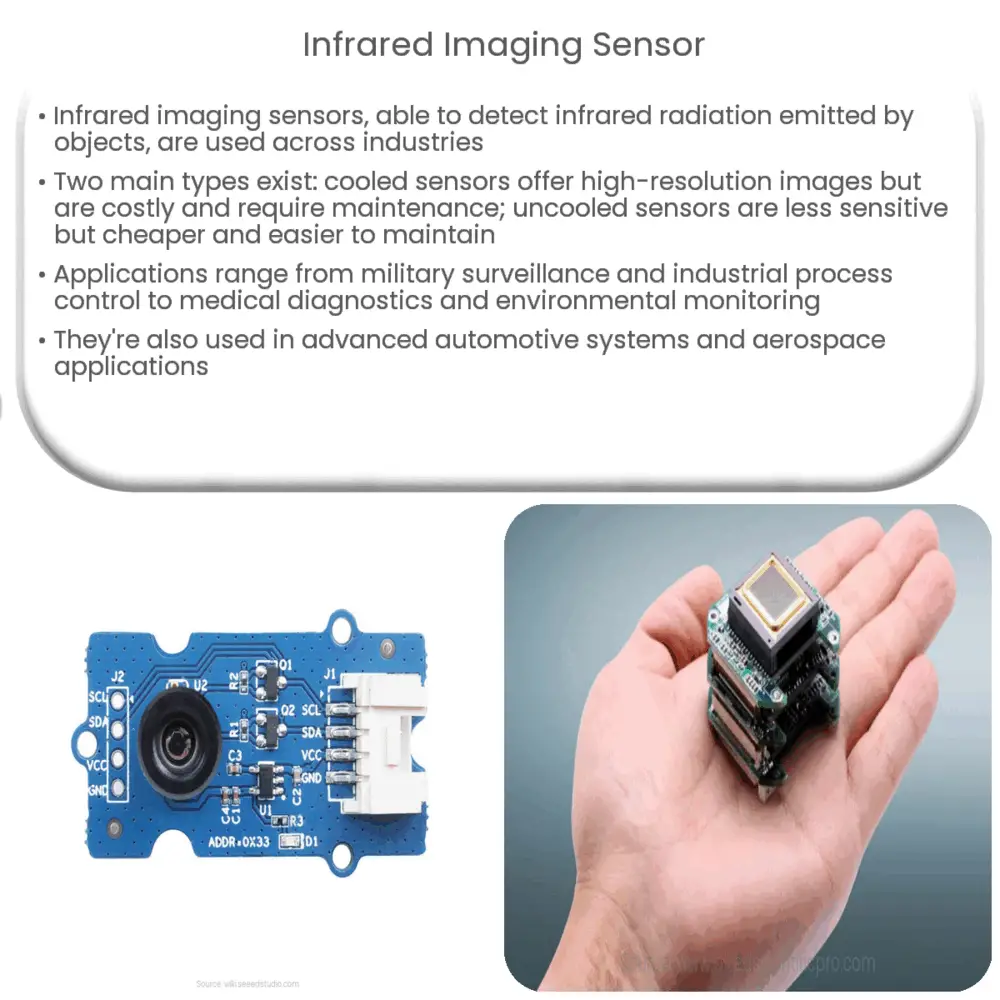Infrared imaging sensors detect and measure infrared radiation, enabling various applications in defense, industry, medical, and environmental sectors.

Infrared Imaging Sensor: An Overview
Introduction
Infrared imaging sensors, commonly known as IR sensors, have been widely used across various industries due to their capability to detect infrared radiation emitted by objects. These sensors operate in different wavelengths of the infrared spectrum, making them versatile tools for various applications. In this article, we will explore the working principle of infrared imaging sensors, their types, and their applications in different sectors.
Working Principle of Infrared Imaging Sensors
Infrared imaging sensors detect and measure the infrared radiation emitted by objects. This radiation, invisible to the human eye, carries thermal information that can be captured and processed by the sensor. The working principle of these sensors can be explained through the concept of blackbody radiation, which states that all objects above absolute zero emit infrared radiation.
The intensity of the emitted radiation is directly proportional to the temperature of the object, making it possible to determine the temperature distribution of an object by measuring its emitted radiation. Infrared imaging sensors work by converting the detected radiation into an electrical signal, which is then processed and converted into a visual representation called a thermogram.
Types of Infrared Imaging Sensors
There are two main types of infrared imaging sensors: cooled and uncooled sensors. The choice between the two depends on the specific requirements of the application.
Cooled Infrared Sensors
Cooled infrared sensors use a cryogenic cooling system to lower the temperature of the sensor to a level below that of the objects being observed. This cooling process significantly reduces the noise produced by the sensor, resulting in high-resolution images and better sensitivity. However, cooled sensors have some drawbacks, such as higher cost, increased power consumption, and the need for regular maintenance.
Uncooled Infrared Sensors
Uncooled infrared sensors, on the other hand, operate at room temperature and do not require any cooling mechanism. These sensors are generally less sensitive and have a lower resolution compared to cooled sensors, but they offer advantages such as lower cost, longer lifespan, and minimal maintenance requirements.
Applications of Infrared Imaging Sensors
Infrared imaging sensors are utilized in a wide range of industries and applications, including:
- Military and Defense: Infrared sensors are used for surveillance, target detection, and tracking, as well as night vision systems in military vehicles.
- Industrial: These sensors can be used for temperature monitoring, process control, and quality assurance in various manufacturing processes.
- Medical: Infrared imaging is employed in diagnostic procedures, such as thermography for detecting inflammation and monitoring blood flow.
Environmental Monitoring
Infrared imaging sensors play a crucial role in environmental monitoring by enabling the detection of gas leaks, monitoring air quality, and assessing forest fires. These sensors can also aid in studying climate change by measuring the Earth’s surface temperature and identifying heat islands in urban areas.
Automotive
Advanced driver assistance systems (ADAS) and autonomous vehicles use infrared imaging sensors to enhance their vision capabilities, particularly in low-light conditions. These sensors can detect pedestrians, animals, and other obstacles on the road, contributing to improved safety and reduced accidents.
Aerospace
Infrared sensors are commonly used in aerospace applications for various purposes, such as satellite-based Earth observation, monitoring temperature changes in aircraft components, and identifying hotspots on runways to improve safety.
Security and Surveillance
Infrared imaging sensors are widely used in security and surveillance applications for monitoring areas in low-light or no-light conditions. They can detect intruders, trespassers, and unauthorized activities without being affected by darkness or poor lighting conditions, providing an added layer of security.
Conclusion
Infrared imaging sensors have proven to be invaluable tools in various industries due to their ability to detect and measure infrared radiation emitted by objects. Their versatility and wide range of applications make them an essential technology for multiple sectors, including military, industrial, medical, environmental, automotive, aerospace, and security. As research and development continue to advance the capabilities of these sensors, we can expect to see even more innovative applications in the coming years, further demonstrating the importance of infrared imaging technology.

